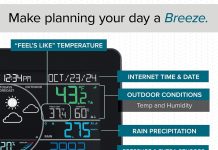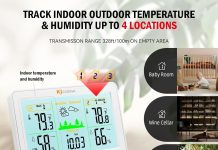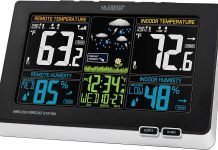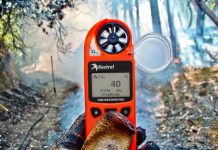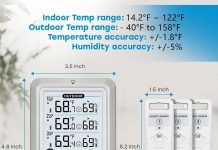Imagine a world where your home not only keeps you comfortable, but also keeps you informed about the weather outside. Well, that world might be closer than you think. In this article, we explore the exciting possibility of integrating home weather station data with smart home systems. From tracking temperature and humidity to predicting rain and wind, we delve into the potential benefits and challenges of this integration. So, put on your weather-geek hat and join us as we uncover the fascinating world of weather-savvy smart homes.
Review contents
Overview of Home Weather Stations
Home weather stations are devices designed to measure and monitor weather conditions in and around your home. These stations use a combination of sensors and instruments to collect data such as temperature, humidity, wind speed, and precipitation. The purpose of home weather stations is to provide homeowners with accurate and real-time information about the weather in their immediate environment.
Types of Home Weather Stations
There are two main types of home weather stations: standalone weather stations and networked weather stations. Standalone weather stations consist of a console that displays weather data collected by sensors placed outside. Networked weather stations, on the other hand, are connected to the internet and allow you to access your weather data remotely through a mobile app or a web interface.
Features and Sensors of Home Weather Stations
Home weather stations come equipped with a variety of features and sensors to provide comprehensive weather information. Some common sensors found in these stations include:
- Thermometer: Measures the temperature both indoors and outdoors.
- Hygrometer: Measures the humidity level.
- Anemometer: Measures wind speed and direction.
- Rain gauge: Measures precipitation such as rainfall or snowfall.
- Barometer: Measures atmospheric pressure.
- UV sensor: Measures the intensity of ultraviolet (UV) radiation.
- Solar radiation sensor: Measures the amount of solar radiation received.
These sensors work together to gather accurate and detailed weather data, which can be crucial for planning outdoor activities, gardening, or simply being aware of the current conditions.
Definition of Smart Home Systems
Smart home systems, also known as home automation systems, are integrated networks of devices and appliances that can be controlled remotely and automated to perform certain tasks. These systems typically include devices such as smart thermostats, lighting, security cameras, and door locks, which can be interconnected and controlled through a central hub or a mobile app.
Benefits of Integrating Home Weather Stations with Smart Home Systems
Integrating home weather stations with smart home systems brings several benefits to homeowners. Firstly, it allows for the automation of certain tasks based on real-time weather data. For example, if a home weather station detects rain, the smart home system can automatically close the windows and adjust the thermostat to conserve energy. Secondly, integrating weather data with smart home systems can enhance the overall functionality and efficiency of the system. By incorporating weather information, the smart home system can make more informed decisions, such as adjusting heating and cooling settings based on the current temperature and humidity levels. Lastly, integrating home weather stations with smart home systems can provide homeowners with a more comprehensive view of their home environment. They can easily access weather data alongside other information about their home, such as energy usage or security.
Challenges and Limitations of Integration
While integrating home weather stations with smart home systems offers numerous benefits, there are also challenges and limitations to consider. One of the main challenges is compatibility issues between different communication protocols used by the weather station and smart home devices. Some weather stations may use proprietary protocols that are not compatible with certain smart home systems, which can hinder integration. Furthermore, interoperability between smart home devices from different brands can also pose a challenge. It is important to ensure that all devices have the ability to communicate and share data seamlessly. Lastly, privacy and security concerns are significant limitations to integration. Weather data can contain sensitive information about a homeowner’s whereabouts and habits, so it is crucial to implement robust security measures to protect this data from unauthorized access.
Data Integration Possibilities
Integrating home weather station data with smart home systems opens up a wide range of possibilities for homeowners. Here are some examples:
Real-time Weather Data
By integrating a home weather station with a smart home system, homeowners can access real-time weather data through the smart home’s interface. This includes information such as temperature, humidity, wind speed, and precipitation. This real-time data can be valuable for making informed decisions, such as adjusting heating or cooling settings, deciding whether to water plants, or planning outdoor activities.
Climate Control and Energy Efficiency
Integrating weather station data with a smart thermostat allows for more intelligent climate control. The smart thermostat can analyze the weather data to determine the optimal temperature settings based on the current conditions. For example, on a hot and sunny day, the smart thermostat can couple the weather station’s data with the homeowners’ desired comfort level to automatically adjust the cooling settings, potentially saving energy and reducing utility costs.
Automated Actions Based on Weather Conditions
Homeowners can configure their smart home system to perform automated actions based on specific weather conditions detected by the weather station. For instance, if the weather station indicates strong winds, the smart home system can close motorized blinds or retract awnings to protect against potential damage. Similarly, if rain is detected, the smart system can close windows, activate leak detection sensors, and adjust irrigation schedules accordingly.
Compatibility Issues
Integrating home weather stations with smart home systems may face compatibility issues that need to be addressed. These include:
Different Communication Protocols
Home weather stations and smart home devices often use different communication protocols to transmit and receive data. It is important to ensure that the weather station and smart home system use compatible protocols or have the ability to interface with each other. This may require additional hardware or software configurations to enable seamless integration.
Interoperability between Smart Home Devices
In addition to communication protocols, interoperability between smart home devices from different manufacturers can be a challenge. It is important to choose devices that are known to be compatible with popular smart home systems and can work together without any compatibility issues. This may involve researching and selecting devices from the same ecosystem or using third-party integration platforms to bridge the gap between devices.
Privacy and Security Concerns
Integrating home weather station data with smart home systems raises privacy and security concerns. Weather data, combined with other data collected by smart home devices, can provide insights into a homeowner’s habits and whereabouts. It is crucial to implement strong security measures, such as encryption and authentication, to protect this sensitive data and prevent unauthorized access.
Popular Home Weather Stations
There are several popular home weather station brands available on the market, each offering unique features and capabilities. Here are three notable brands:
Brand 1
Brand 1 offers a range of weather stations that provide accurate and reliable weather data. Their stations come equipped with a variety of sensors, including temperature, humidity, wind, and rain sensors. They also offer user-friendly interfaces and the ability to connect to popular smart home systems.
Brand 2
Brand 2 specializes in networked weather stations that allow homeowners to monitor weather data remotely. Their stations feature advanced sensors and can provide real-time weather updates through their mobile app or web interface. Brand 2 also offers seamless integration with leading smart home systems, making it easy to incorporate weather data into your smart home setup.
Brand 3
Brand 3 focuses on highly accurate and professional-grade weather stations for weather enthusiasts and professionals. Their stations feature advanced sensors and allow for the collection of highly detailed weather data. While Brand 3’s stations may be more suited for advanced users, they also offer integration options with smart home systems, providing a comprehensive weather monitoring solution.
Smart Home Systems and Providers
A variety of smart home systems are available on the market, each with its own set of features and capabilities. Here are some major smart home systems to consider:
Major Smart Home Systems Available
-
System 1: This smart home system offers a wide range of compatible devices, including smart thermostats, lighting, security cameras, and door locks. It provides a user-friendly interface for controlling and monitoring these devices, as well as integration options for weather stations.
-
System 2: With System 2, homeowners can connect and control various smart devices using a central hub or a mobile app. This system offers advanced automation features and seamless integration with popular smart home devices, including weather stations.
-
System 3: System 3 provides an extensive ecosystem of smart home devices and a comprehensive mobile app interface. It offers integration options for weather stations, allowing homeowners to access weather data alongside other smart home functionalities.
Leading Smart Home System Providers
-
Provider 1: This provider is known for its cutting-edge smart home technology and a wide range of compatible devices. They offer a hub-based system that allows for the integration of different smart devices, including weather stations.
-
Provider 2: Provider 2 specializes in seamless home automation solutions, with a focus on user-friendly interfaces and compatibility with various smart devices. Their smart home system offers robust integration capabilities with weather stations for enhanced functionality.
-
Provider 3: This provider offers a comprehensive smart home ecosystem with integrated devices and a centralized hub. They prioritize interoperability and offer integration options for a variety of smart devices, including weather stations.
Integration Methods and Tools
To integrate a home weather station with a smart home system, certain methods and tools can be used. Here are some common options:
APIs and Integration Platforms
Many smart home systems provide APIs (Application Programming Interfaces) that allow developers to integrate third-party devices, such as home weather stations, into their systems. By leveraging these APIs, homeowners can connect their weather stations and access weather data through their smart home system’s interface. Additionally, there are third-party integration platforms available that act as bridges between different devices and systems, enabling seamless communication and data sharing.
IOT Hubs and Gateways
IoT (Internet of Things) hubs and gateways can also be used to facilitate integration between home weather stations and smart home systems. These devices act as centralized points of control and communication, allowing homeowners to connect and manage multiple devices, including weather stations. IoT hubs and gateways often support various protocols, making it easier to bridge the gap between different devices and systems.
Setup and Configuration Process
Setting up and configuring the integration of a home weather station with a smart home system typically involves the following steps:
Connecting Home Weather Station to Smart Home System
The first step is to connect the home weather station to the smart home system. This may involve connecting the weather station’s console or base station to the smart home system’s hub or gateway. Depending on the devices and systems involved, this connection can be established wirelessly or through physical connections, such as USB or Ethernet.
Configuring Automated Actions and Rules
Once the weather station is connected to the smart home system, homeowners can configure automated actions and rules based on weather conditions. This can typically be done through the smart home system’s interface or mobile app. Homeowners can set specific triggers, such as certain temperatures or wind speeds, to initiate automated actions, such as adjusting thermostat settings or closing motorized blinds.
Real-life Examples
To better understand the integration of home weather stations with smart home systems, here are some real-life use cases:
Use Case 1: Smart Thermostat and Weather Station Integration
In this scenario, a homeowner has a smart thermostat and a home weather station. By integrating the two, the smart thermostat can access real-time weather data from the weather station and adjust temperature settings accordingly. For example, if the weather station detects that it is a sunny day with high temperatures, the smart thermostat can increase the cooling settings to ensure optimal comfort.
Use Case 2: Sprinkler System and Weather Station Integration
In this use case, a homeowner integrates their home weather station with a smart sprinkler system. By combining weather data with the sprinkler system, the homeowner can optimize their watering schedule based on real-time conditions. If the weather station detects sufficient rainfall, the smart sprinkler system can automatically skip watering for that day, conserving water and preventing overwatering.
Use Case 3: Outdoor Lighting and Weather Station Integration
In this example, a homeowner integrates their home weather station with their outdoor lighting system. By connecting the weather station to the lighting system, the homeowner can automate outdoor lighting based on weather conditions. For instance, if the weather station detects low light levels due to cloudy weather, the lighting system can automatically activate outdoor lights to provide sufficient illumination.
Future Developments and Possibilities
The integration of home weather stations with smart home systems continues to evolve, offering exciting possibilities for homeowners. Here are some potential future developments:
Advancements in Data Integration
As technology advances, we can expect more seamless integration between home weather stations and smart home systems. This includes improved compatibility between devices, standardized communication protocols, and simplified setup processes. The future may bring more plug-and-play solutions that make it easier for homeowners to integrate their weather stations with their smart home systems.
Expansion of Integrable Devices and Systems
With the growing popularity of smart home devices, we can anticipate an increase in the number of weather stations and smart home systems that offer integration options. More brands and manufacturers are likely to develop weather stations with built-in compatibility for popular smart home systems, expanding the range of devices that can be seamlessly integrated.
Potential Benefits for Homeowners
The integration of home weather stations with smart home systems holds great potential for homeowners. By leveraging weather data in conjunction with other smart home devices, homeowners can achieve enhanced comfort, energy efficiency, and convenience. For example, with more advanced integration, smart home systems may be able to adjust various devices based on upcoming weather forecasts, allowing homeowners to better plan their day and make informed decisions about their home environment.
In conclusion, integrating home weather stations with smart home systems offers numerous benefits and possibilities for homeowners. By leveraging real-time weather data and integrating it with smart devices, homeowners can achieve more efficient climate control, automated actions based on weather conditions, and a comprehensive view of their home environment. While there may be challenges and compatibility issues to navigate, the future looks promising for seamless and intelligent integration between home weather stations and smart home systems.


